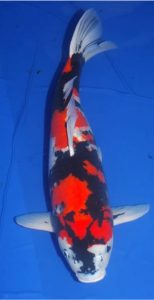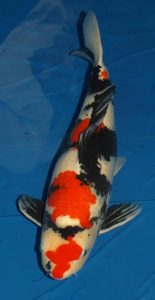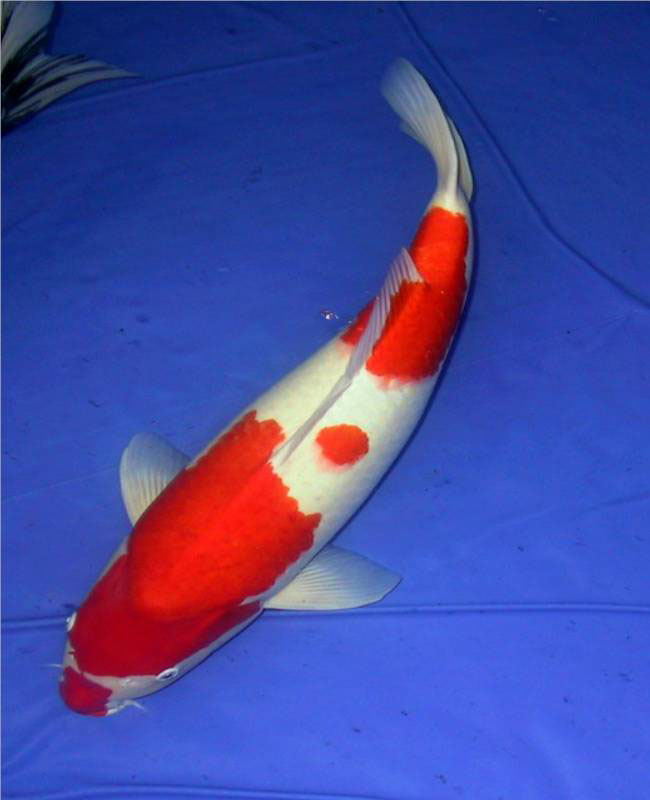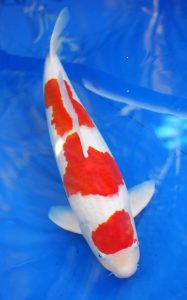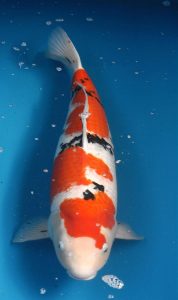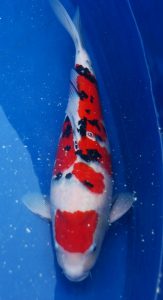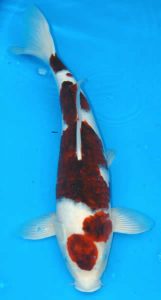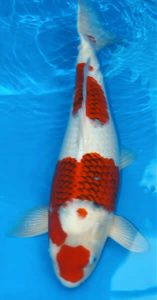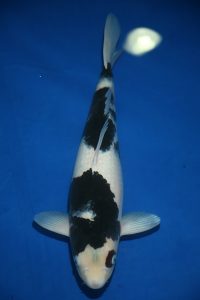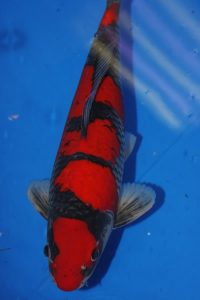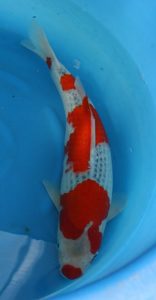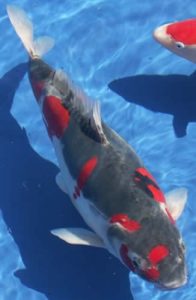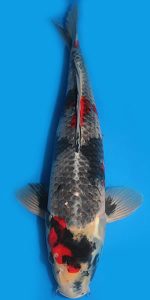Category Archives: Koi and Ponds
New Pond Snydrome
New Pond Syndrome
Is it wabbit season? Is it duck season? No, Elmer, it’s Ponding Season.
Your contractor has vanished over the horizon at just under lightspeed to deposit that check. Alternatively (and much more likely), the backyard project that you started this spring – as soon as the ground thawed out enough to allow a shovel to penetrate the permafrost – is lined, decorated, plumbed, pumped, skimmered and maybe even bottom-drained. It’s hooked up to a spiffy new filter. The water’s in, the pumps are on and it’s time for fish! Lotsa fish! Got 5000 gallons of fresh water just sitting there!
Not. So. Fast.
Ponding is seriously addictive. It is hard for beginners to recognize that they are starting up a complex, artificial and often delicate ecosystem that is going to take Ma Nature’s own sweet time to mature. The temptation to add fish is nearly overwhelming. Especially koi – several contractors we’ve dealt with over the years actually offer new pond owners several sacrificial koi as they vanish. The First Law of Ponding is the first to take hold. Yeah, there is always a better fish. The trick is to keep them alive long enough to enjoy them.
Any backyard pond relies on a number of interlocking conditions to maintain optimum water quality and fish health.
- Reliable water sources, preferably free of chlorine and other additives (either chemically treated, well water or prefiltered)
- Enough dissolved carbonates (KH) to stabilize pH. Every molecule of ammonia that is converted to nitrate generates five molecules of acid. The carbonate salts soak up the acid and prevent the pH from dropping low enough to kill bacteria and, yes, fish. It’s called a “pH crash”. The carbonates are dissolved in the water as it comes from whatever source you are using. Water from the Great Lakes has a comfortable 120 parts per million from the limestone the water flows through. Depending on your source, your levels will be different. A good range is 80 to 120 ppm.
- Good oxygenation with turbulent waterfalls
- Competent pumps and filters
- Stable temperatures from depth and shade
- Good water movement without dead spots
- A clean and easily-maintained bottom
- And, most importantly, a way of getting rid of the waste products that those fish are generating.
This is biofiltration, also called nitrification, and it relies on the activity of several species of naturally-occurring bacteria. They need media with a large enough surface area to allow them to establish a biofilm in which to interact with the water and convert the ammonia the fish are producing to relatively nontoxic nitrates.
New ponds do not have any of these populations present at startup. It takes weeks to get them introduced and functioning. The different bacteria do not all develop simultaneously. The bacteria that convert ammonia (toxic at moderate levels, worse with higher water temperatures and higher pH) to nitrite (toxic under any conditions) develop first, usually over a one to two-week period after startup. The bacteria that take nitrite to far-less-toxic nitrates take several more weeks to develop, regardless of the excellence of the new high-tech filters. Almost all the bottled “Insta-Startup” bacterial additives available commercially are not terribly effective, with one probable exception.* {A better solution would be to get a generous sample of active filter media or mat from a mature pond and put it into your filter (if possible) or even just into the pond.}
The result is called “New Pond Syndrome.” You’ll know you’ve got it when all those new fish you put in on day 1 are dead by day 15. The first wave died from the ammonia and the survivors succumbed to nitrite poisoning (similar to carbon monoxide poisoning in mammals). Water testing will reveal a rapid uptick in ammonia as the fish go in, followed by a gradual decrease. As ammonia drops, nitrite climbs and, over a week or so, begins to drop off. You are done with the first stage of this when both of these levels have returned to zero.
The preventative solution to this initial problem is either to pretreat the pond with household (NOT sudsy!) ammonia and wait for the levels to drop before adding any fish (not recommended) or adding only one or two fish at first and feed very lightly, again, until the levels drop to zero. More fish can be added gradually, to the capacity of the filter and pond.
We call it a syndrome because it doesn’t go away. It generally takes a backyard pond five to six years to achieve a robust enough population of filter bacteria to survive stresses. The most common stressor is winter shutdown. For many ponders, this means shutting down the pumps and filters and blowing out the plumbing to prevent freezing related catastrophes. This deprives the bacteria in the filters of oxygen; the cultures left on the pond walls go dormant. Come spring, these populations will revive, but with the same timetable the owners saw at startup. This does improve as the pond matures, but it is still a major water quality issue every spring, especially as the fish wake up and demand to be fed.
The simplest solution to this is to protect the pond with a weather cover or poly house. Add strategies to keep the water temperatures at or around 40 degrees F., maintaining flow through the filters all winter. The filter bacteria do go dormant, but bounce back very quickly in the spring.
An even simpler solution to this problem (although logistically challenging) is to move the family establishment somewhere without winter and dig your pond there.
A popular alternative to “high-tech” biofiltration is the installation of a bog filter. This is basically a separate container of water, preferably about 20% of your pond’s volume, heavily planted with aquatic vegetation. Water arrives from your pumps and flows around the roots of the plants which remove the ammonia and also provide some mechanical filtration. From there, the water descends to your pond. Fish do not belong in the bog. A new startup with a bog actually takes much longer than a high-tech system, since it requires the plantings to settle in and mature. While these tend to be hardy perennials, they do die back in the winter and have to re-establish themselves in the spring. Obviously not a problem if you do not have winter.
The most common error that can perpetuate New Pond Syndrome indefinitely is the mistaken assumption that a backyard pond needs to be spiffy-clean everywhere: drained, pressure-washed and stripped of all that nasty algae, refilled and dosed with ineffective supplements. It happens more often with gravel-bottomed liner ponds, since the gravel traps sludge and there’s no other way of getting it out. Pressure washers classically hook up to the garden tap delivering cholera-proof chlorinated water to the device and onward to the entire pond system, killing the bacteria and restarting perpetual NPS.
So, some advice:
- New pond? Start slow, only a few fish and feed lightly
- Water test daily until ammonia and nitrites are zero.
- Beware of Spring. Feed sparingly as the pond wakes up.
- Avoid winter if at all possible
- Protect the pond in the winter. Keep the pumps and filters running if at all possible.
- Do not put gravel on the bottom of the pond. The guys who want you to do this need an excuse to come back every six months to pressure wash your pond and destroy your filters. Again. For $1000 a pop.
- Do not pressure wash your pond. Ever.
- Never add chlorinated water to your pond or wash any part of your filter with chlorinated water.
- Bacteria boosters mostly do not work.*
* A company called Fritz-Zyme provides start-up cultures for large aquarium installations (like the Shedd in Chicago) that have to be used within 24-48 hours after initial prep. This is shipped refrigerated and costs $$$$$$$$$$$. They make a hobbyist version, also shipped cold, that works well. It’s called TurboStart 700 and works over a 5-day period.)
By: Bob Passovoy
Published 2/8/22
Who’s on pHirst?
Who’s on pHirst?
(This article is being written during the Super Bowl. (Actually Super Bowl XX, 1985. Bears vs. Patriots. Got it on tape 35 years ago.) So a sports metaphor is appropriate, even if it is baseball!)
Alright, keep your hands off the keyboard. Step away from the door and sit down. Do not run away. We are your friends, and a discussion of pH is not going to hurt you. Much.
Every time pH is mentioned in ponding circles, especially in print, the sound of eyeballs glazing over is well-nigh deafening. I don’t know why this is, but it seems to be one of the hardest things to explain in any fashion that leaves the listener (or reader) conscious and mentating. I’ve seen definitions involving ions and balances and atoms of hydrogen and oxygen. I’ve seen demonstrations of formulas worthy of Einstein and Planck at their most opaque, but I don’t know that I’ve seen much that was useful for the average backyard ponder.
I guess the best way to start is with some generalizations. These are not necessarily the total truth, but as a very wise man once said, they are very useful lies.
- Every pond exists with a balance of acid and alkali (base) components as constituents of the soup that we call pond water.
- Acids are things like lemon juice, vinegar, and the stuff inside your stomach.
- Alkalis are things like quicklime and concrete.
- Both, in high concentrations, can eat holes in things. (Did you really need to know that? No, but it’s fun, so I said it anyway.)
- Both are present to one degree or another in our pond water and are either a part of the water itself or of the minerals (or pollutants!) dissolved in the water.
- If you have equal amounts of acid and base in your water, these balance out and this state is called “neutrality”.
- pH is a convenient way of measuring this balance, with a pH of 7 reflecting the neutral state. Numbers less than 7 indicate a more acid state, and those above 7 a more alkaline condition.
- pH changes are logarithmic (don’t panic!) To quote Norm Meck, my Chemistry guru, each whole unit of change is 10 times more than the previous one. pH 8 has 10 times more base than pH 7, and pH 9 has 10 times more base than pH 8 (100 times more than pH 7!). The same is true for acid at pH values below 7. pH 6 has 10 times more acid than pH 7, and so on.
- Dissolved materials, such as ammonia, are affected by the pH balance in our ponds, and their ability to harm our fish depends on the pH level.
- The bacteria in our filters function best within a narrow range of pH, and sudden changes, especially in the acidic direction (low pH) can wipe out our bioconverters.
- Koi are tolerant of a wide range of pH, as long as it is stable.
There, that didn’t hurt too much, did it?
It isn’t really necessary to completely understand every nuance of the chemistry and physics of pH, but it is important to be able to measure it accurately on a regular basis, to understand the importance of maintaining a stable pH, and the consequences of failing to do so.
Measuring pH
A trip to any pet supply store will present you with a number of choices of pH kits. These range from little bits of paper only one step removed from the litmus paper you played with in science class, to tablets in little indestructible foil pouches, to bottles of mysterious fluids. Regardless of which you buy, a few things need to be considered before you plunk down your money.
- Is the kit you are buying sensitive in the range you need? Ideally, ponds should operate in near-neutral water conditions (7.0-8.5). In reality water pH can vary anywhere between 6 and 8.5 and still be perfectly healthy. The pH can vary with time of day, water source, additives, pollutants, plantings and a host of other influences. As long as the changes are gradual, koi tend to be pretty tolerant. Bio-converting bacteria tend to lose efficiency at low pH, and pH above 9 is thought to damage koi kidneys. Many pH test kits vary in accuracy and are accurate in only a specific range of pH. A kit with a very wide range may not give accurate readings in the range you need. A very accurate kit within a narrow range of pH won’t let you know if you are in trouble outside that range. In general, any kit that will give you easy-to-detect color changes in a range between 5 and 10 (“wide-range”) is satisfactory for pond use. For those of us with color-blindness or a need for micro-management, electronic pH meters are available. These require frequent calibration and maintenance and are often fragile. The average Joe Ponder need not make this investment.
- Are your reagents fresh? Testing materials bought from pet supply stores are often ordered months in advance, and can sit in storage areas (often without temperature or moisture protection) for weeks to months. Before that, they can reside in warehouses for as long or longer. Even specialty suppliers have been known to send old and inaccurate reagents to hobbyists. Your best bet is to order from a supplier with a good reputation for reliable reagents and a mechanism for tracking lots of reagents by date of manufacture. Most pH kits have a shelf life of about two years. After that they should be replaced.
- Is the kit easy to use? Complicated testing procedures will discourage you from keeping up with your monitoring program. Most good pH reagent kits are one-step and can be read almost immediately. Any kit with instructions written in engrish as translated from the original Japanese by a native Tagalog-speaking Scotsman should be gently replaced on the rack, as should any kit that requires endless shaking of an insoluble and indestructible tablet.
- Will the kit last the season? Many reagents are sensitive to deterioration by moisture, heat and/or sunlight. Make sure your kit is appropriately packaged and the quantities are sufficient to last you long enough to make the purchase worth your while. If you are buying paper strips, for instance, water-tight packaging is a must!
- Why do I have to measure pH, anyway? Ah, now. On to the next section.
Maintaining stable pH
pH is not a fixed value in any pond. It is a constantly changing dynamic balance between acid and base that can be affected by a multitude of environmental influences. Without some stabilizing mechanism, pH can vary widely and rapidly, not a good thing for the fish or the filter. What keeps this from happening is the presence of dissolved salts of magnesium, calcium and other minerals which are capable of swapping acid and base components within the pond environment. These are present in most water sources, so that frequent water changes can replenish these salts, which are broken down and consumed by organic acids produced by common pond bacteria. If you think of these salts as a big sponge, sopping up the acids produced by rainfall, fish, bacteria and other sources, and minimizing the effect the added acids have on the pond environment, you are close enough to the truth to make it useful. We call this “pH cushion” a buffer, we measure it as alkalinity(or KH), and the action of alkalinity on a pond is its buffering capacity.
The term we use for the strength of this protection against pH shift is Alkalinity, measured in parts per million (ppm), and test kits, subject to the same questions and requirements as your pH kit, are widely available. Ideal alkalinity is around 100 ppm; a range of 80-200 is acceptable for most ponds. This means your test kit will need a range of 0-200 to be useful.
Attempts to change pond pH rapidly by the addition of acid or alkali directly to the water usually result in major stress to the fish and filter. As long as the pH is stable, ranges of pH between 6 and 8.5 are well-tolerated, and it is a better idea to find ways of stabilizing your pH. This is actually fairly easy to do by watching your alkalinity, and supplementing it if necessary. Supplements can be as simple as a “biscuit” of plaster of Paris placed in the pond and replaced as it is consumed works well. Emergency corrections of alkalinity can be made with simple Arm & Hammer baking soda (pure sodium bicarbonate). Most ponders of my acquaintance just use the bicarb. It’s cheap, easy to find and eco-friendly. 1 pound of the stuff per 1000 gallons of water buys you 70 ppm alkalinity.
So… What if I Don’t?
Wide shifts in pH over short periods of time are stressful to both fish and filters. Water that is very alkaline (pH 9.0) has been suspected of damaging koi kidneys. Since the addition of acids to ponds is very tricky, a water source that is less alkaline may be preferable.
Sudden reductions in pond pH can occur in liner ponds without access to rock or other sources of salts, as alkalinity is consumed by the production of organic acids, reducing its buffering capacity. The most common source of these acids is the action of our beneficial bacteria as it converts ammonia to nitrate. Each molecule of ammonia that is processed results in the production of five molecules of acid.
For those of you out there with a biochemical bent, here’s what is really going on:
NH3 (ammonia) + O2 (oxygen) à NO2 (nitrite) + 3H+ (hydrogen ions=acid) + 2 electrons
This reaction is powered by Nitrosomonas and Comammox bacteria, which show up earliest in a new pond and cause the famous and dangerous “nitrite spike” in new ponds and any pond shut down for winter.
NO2 + H2O (water) à NO3 (nitrate) + 2 H+ +2 electrons
Nitrobacter, Nitrospora and Comammox bacteria handle this step and tend to wake up 1-3 weeks later. Nitrates are relatively nontoxic and can be eliminated by vigorous exposure to oxygen in a bioreactor or Bakki shower.
The key take-away is that each molecule of ammonia that your fish generates will generate 5 molecules of acid that has to be buffered by your pond’s alkalinity. A few hot days with heavy feeding, or even a heavy rainstorm (rainwater contains no dissolved salts!) can drop your alkalinity to dangerously low levels very quickly.
An efficient biofilter doing its job in high summer in a heavily-populated pond can chew up the available buffer very quickly. When this happens, the pH can drop suddenly and without warning, a phenomenon called a “pH crash”, which can drop the pond pH to 5 or less. Since the bio-converting bacteria in your filters lose efficiency at pH below 6, acid conditions of this intensity essentially turn off your filter’s ability to process the ammonia your fish are still making. It will now take weeks to get it back, since very low pH will kill a significant portion of your bacterial population. Your fish are protected in the short run because ammonia becomes ionized at low pH, and is considerably less toxic. Trying to correct the pH towards neutral without first binding the ammonia with an additive will de-ionize the ammonia and kill the fish.
Overall, weekly monitoring of pH and alkalinity, and supplementing the alkalinity as needed, can save you a lot of trouble and heartbreak, and get you that much closer to an ideal pond.
Respectfully submitted,
Bob Passovoy
Pimp my Pond
Pimp my Pond by Dr. Bob Passovoy
Well, now you have gone and done it. For whatever reason, you are now a ponder. Your contractor, check in hand, has just vanished over the horizon in a cloud of dust, leaving you with your spiffy new backyard water feature. If you are very lucky and very smart, you will have had the benefit of friends grown old in the hobby and a contractor who knows his stuff. If you have the usual beginner’s luck, you’ve got a shallow hole in the ground with about 24 to 36 inches of water in it, a few (expensive) sacrificial koi, a skimmer at one end and a tub of water at the other, casting a wonderful smooth sheet of water into the (for a while) limpid depths.
This is the most dangerous time for a ponder. The Three Laws have bit you and the First Law (There is always a better fish) is generally the initial force to take hold. It is too early for you to realize the force of the Third Law (There is never enough water). You haven’t had the chance yet to overstock and overfeed.
You’ll find the sheer power of the Second Law growing as you gain experience and sophistication. It is of the Second Law we speak. There is always a better filter. For filter, substitute GADGET.
As your pond increases in size and your expertise grows with experience, you’ll begin to notice…deficiencies…in the way your system handles stress, weather, fish load and water quality, and you’ll be looking for ways to fix them.
Forthwith, a series of challenges and what could, given the right conditions, develop into a very impressive Christmas wish list.
Challenge #1 occurs as you settle into the hobby and your fish grow in size and numbers. Your water warms up as it is bathed by the sun’s happy rays and you have achieved…ALGAE! It starts as a faint green tinge to the water and suddenly you can’t see the fish. You need a solution because you read somewhere that floating microscopic algae sucks up oxygen in the dark. Off to the pet/sortapond store where the guy tries to sell you a bottle of something that is guaranteed to kill off all the algae in your pond, no worries. Just in time you remember that any chemical you put in, stays in until you can water-change it out. You also reason that the proteinaceous gook that’ll collect as the plant life dies will stay in the pond forever as well, giving you that healthy head of foam at the foot of your falls and that odd brown tinge to the water. So, nope. No chemicals. You needs a GADGET! There are a few.
First up in your mind are UV (ultraviolet) clarifiers. These are not filters as such, nor are they “sterilizers” unless you are ready to shell out several thousand dollars on an industrial-strength array capable of knocking a GPS satellite out of orbit. These high-end devices, set up properly, are powerful enough to kill some motile parasites and even see use as ozone generators, but they are aquaculture tools, not designed for backyard ponds. Hobbyist UV units will cost between $50 to $300, depending on the design and durability. They run with bulb capacity between 25 to 100 watts as a rule, the bulbs retaining their punch for about a year. The key to their effectiveness is the amount of time the water piped into the unit stays there. Most hobbyist UV units are set up with 1-inch or 1 ½ inch connectors to slow the flow. For this reason, the UV unit should always be set up on a diversion loop on your filter outlet pipe so that full flow back to the pond is not impeded, remembering that this fits in after the water has been mechanically and biologically filtered. UV in this application does not kill anything. It does cut down on floating algae by damaging its ability to reproduce. It will not affect anything in the pond itself, so don’t expect all that hair algae to disappear. These units need their bulbs changed out every year, and the plastic-bodied devices tend to get brittle after a few years of UV exposure and will disintegrate. Look for UV with stainless steel chambers and robust fittings. In general, UV is affordable and works well within its narrow application.
MAGNETISM! Nobody knows what magnets do when you wrap them around pipes. We do know that they do not affect algae.
IonGen: This infernal little device kills algae. And plants. And, eventually, fish. It is a block of copper or zinc hooked up to a DC power source and then exposed to your pond water. It uses the Mad Science principle of electrolysis to erode the metal, releasing molecular copper or zinc into the water. As it operates, the metallic ion concentration becomes toxic enough to kill off algae (leaving the organic pollutants in the pond for you to deal with). As the unit continues to run, levels of copper can easily reach levels toxic to fish. Everything dies. Do not waste your money. There are better solutions to this problem.
Ozone: Oboyoboyoboy! High-tech Mad Science! Ozone is the ultimate oxidizer. It breaks down proteinaceous waste, kills parasites, kills algae, kills bacteria, and if it gets out of control, toasts off fish gills. Alan LaPointe, the head water-quality guy at the Shedd Aquarium wears a beeper 24-7. It connects him to the equally 24/7 monitoring staff whose job is to watch the ozone levels. All The Time. He says that if you are not prepared to exert this level of effort and vigilance, do not do ozone.
So now what? You got your UV and you still got algae. Maybe less than before, and more hair algae than floating, but still algae. Now is the time to remember what promotes algae growth. Warm water. Sunlight. Food. Food? Algae eat ammonia. Fish make ammonia. You got lotsa fish. The algae are happily taking the ammonia out of your system and converting it into plant. You want it to stop? Get rid of the ammonia. You need MORE FILTER!
Prefiltration: Koi are bottom-feeding fish that love mud. In their natural habitat, you’ll never see them. Koi keepers are natural voyeurs and want to see their fish all the time. “Gin-clear” water is the holy grail of the backyard ponder, even if it’s not the ideal habitat for a carp, and that means no floating crud. Getting the big, visible chunks-‘o-stuff out of the water improves the pond’s appearance and reduces the amount of time you’ll have to spend flushing the crud out of your biofilters. Prefilters range in complexity from a piece of filter mat wrapped around that submersible pump to stainless steel screens with holes too small to see. Oddly, as the complexity of the device increases, maintenance on the device decreases. What’s most important here is that the water hits this first, before the biofilter and definitely before the pump.
Seives: Usually a plastic basket that fits over the inlet of your submersible. Fouls instantly. Also found as a basket on the inlet side of dry-land pumps. By itself, also high-maintenance.
Foam pads and mats: Placed somewhere between the inlet to your pump and the pump itself, usually contained in a box or just wrapped over the inlet, these have the advantage of being simple and cheap. The downside is that they foul quickly and need to be cleaned frequently, often twice a day at the season’s peak.
Vortex: Basically a big tub with a conical bottom. Water comes in passively from the pond and enters the tub in such a way as to create a constant swirling motion. Larger particles settle out to the bottom and the cleared water is drawn off the top and sent on to the filter or the pump. Simple and easy to maintain, but it takes up a lot of space.
Turbovortex: This is a prefilter adapted for closed systems. It is very compact, basically a small upflow filter partially filled with a coarse mechanical media. ¾-inch bioballs are most frequently used. It does need daily backflushing and the valving systems available to allow you to do this range from “instant-foul-and-fail” to “impossibly arcane”. I have one. It works. Don’t ask how.
High-tech sieve: These range all the way from self-contained large-volume sieves in flashy stainless cylinders to elegant bow-screen sieves with teeny-tiny holes and elaborate backwashing systems.
As the complexity of the system increases, so does the thoroughness of the mechanical prefiltration and the cost. Adding prefiltration boosts the efficiency of your bioconverters, but you’ll need to shop around to find the prefilter that fits your pond best.
Biofiltration: The idea here is to provide the maximum amount of surface area for your filter bacteria to stand on in the minimum amount of space. Biofiltering bacteria rely on biofilms which stick to surfaces. Filter media which provide a very high surface area for a given volume and do not foul or clog are preferred, as are the systems that use them. The system needs to fit the requirements of your pond from the standpoint of flow and volume and be compatible with whatever pumps you are using. It needs to be reliable and easy to maintain and clean. Beyond that, nothing else matters. Open system, closed/pressurized, Nexus, home-built. They all work. The limiting factors are cost, space and physics. The critical point is whether the system is capable of keeping ammonia and nitrite at or around zero on a consistent basis, regardless of the stress. If it can’t, you need more filter. If it can, you don’t have an algae problem anymore. You do have happy fish. If you have multiple systems, they need to be hooked up in parallel if you have only one inlet. If you have both a skimmer and a bottom drain, split the systems and run them independently, each with its own pump, prefilter and biofilter. This redundancy gives you some safety if either of the systems dies. It also gives you more pipe room to add more toys. Gadgets! Remember?
Dissolved Organics: Otherwise known as protein, foam, gunk, sludge and “that funny brown color that my pond turns in the summer. This is the result of natural processes that involve broken-down sloughed slime coat from the fish, dead bacteria and decomposed plant material. Besides being responsible for that ugly bubbly foam at the base of your falls, it is also a pollutant that degrades water quality and fish health. Better it should be gone. Water changes will dilute it, but getting rid of it requires a Protein Clarifier. Otherwise known as foam fractionators, these have been available to aquarium hobbyists, especially the salt-water reef guys for a long time. Ponders, only in the past five or six years. The principle is simple. Agitate the water enough (Venturi, air or both) and it foams. Foam floats and can be skimmed off, returning the defoamed water to the pond. Commercial units (Clarity and others) are available and adaptable to just about any filter system, and like any purpose-built manufactured gadget, cost big bucks. Generally 900 to 1300 dollars. A brisk search through Google reveals several plans for do-it-yourself projects, mostly involving novel uses of various bits of PVC. These work just as well, and bring the cost down to around fifty bucks. Either way, it is worth the time, money and effort.
Degassing: The end product of biofiltration is Nitrate. The end product of buffering (pH balancing) is carbon dioxide. Both can accumulate and both can negatively affect fish health. Luckily, both are governed by chemical reactions that have a gas at one end of the equation. Get rid of the gas and you get rid of the toxin. Ma Nature provides for this with waterfalls. Big, rough, splashy waterfalls. The idea is to maximize the contact between water and air with turbulence at the air/water interface. Airstones DO NOT DO THIS! They are great at moving water, but there is just not enough surface area on each of those spherical bubbles to allow enough gas exchange to matter. The simplest solution to this problem is to engineer in big splashy waterfalls and fast shallow streams and rapids when you dig the pond. Otherwise, you need more GADGETS(!).
Trickle towers are the simplest and cheapest solution to this problem. In their basic form, they are an upright row of 4-inch PVC pipes filled with coarse filter media (usually bio-balls) standing on end in a trough with an outlet to the pond. Water is pumped to the top of the array through a pipe with holes drilled to allow water to pour freely over the media. CO2 and N2 are released, Oxygen is introduced and the water and fish benefit.
Bakki showers employ the same principle. Water pumped to the top of the system through a spray bar is dumped into a perforated trough filled with coarse filter media. It splashes down to another similarly loaded trough, and another and maybe another and then back to the pond. The media can be ferociously expensive imported Japanese ceramic logs or Tuffy sponges. The system can be a glossy array of purpose-built stainless steel or a stack of plastic window boxes supported by 2x4s. The principle is the same, as is the end result.
Bioreactors work a little differently and are more efficient biofilters while still allowing for efficient degassing. Basically a large barrel with airstones at the bottom hooked to a powerful air pump and filled with a neutrally buoyant media such as Kaldenes. Water flows in from one side of the barrel and exits out the other side as the bubbles agitate the media. This is a low-flow gravity-drained system, more compact and concealable than trickle towers and Bakki showers. Also home-buildable.
Air: Air pumps are one of the essential tools in ponding that everyone forgets and then adds as an afterthought, usually assuming that they’ll solve the dissolved oxygen problems mentioned above. They won’t, but air has lots of other uses. How you supply it depends on what you want it to do.
Agitation: Air moves water better and cheaper than anything else. Once your pond is set up, watch for places where debris collects, both on the surface and on the bottom. These are dead spots and will become home to sludge, anaerobic bacteria and parasites. An airstone supplied by a robust pump will move water out and eliminate the dead spot.
Winter: One of the older techniques for maintaining an open area on an unprotected pond’s surface. Robust air pump, airstone one foot below the water’s surface. Voila! Hole!
Gas exchange: This is your bioreactor speaking…(also your Nexus and Helix filters!)
Filter backflush: Pressurized filters, regardless of the media used, accumulate sludge as a consequence of mechanical and biological activity. As long as the stuff is in the filter, it poses the same risk as it does in your pond. Most filter backwash cycles don’t generate enough turbulence within the filter to shake the crud off the media and the subsequent fouling degrades filter flow and efficiency. Adding an air blower step to your backflush sequence amps up the agitation of the media, shakes out a lot more of the dead stuff and makes the whole backflush process more efficient.
Heat (Southern and Southwestern ponders may ignore this bit): Ice and snow are not your friends, no matter how much you like skiing and skating. Your fish hate it. Ice seals off your pond’s surface, trapping the gaseous breakdown products of the decomposition of that junk on the bottom in the water. Snow carries pollutants and causes major temperature fluctuations. Open water, protected open water is best.
Trough heaters are available everywhere, their purpose is to maintain a small open area on the surface of the water trough so the cows, goats, sheep and horses can get a drink in the winter. When applied to a backyard pond, they have a nasty tendency to fail catastrophically, usually on the coldest days, either just dying and allowing the pond to freeze over, or shorting out, dying while delivering a jolt of 120-volt AC to your fish. This can cause permanent spinal injuries and deformity. These gadgets are inexpensive, but their failure rate under adverse conditions make them a false economy.
A reasonable middle-road solution is to cover your pond in the winter with a poly-house. These are available as kits and I know of at least one business in the Chicago area that will design and build it for you, then set it up in the fall and strike it in the spring. They are relatively inexpensive (cost depending on size, of course) and have the advantage of protecting your pond from environmental changes. With a little added heat to the air under the plastic, your water stays liquid and your pumps can run year-round. Locally, Midwest Trading in St. Charles, IL sells the kits.
At the other end of the scale are the purpose-built pond heaters. Either electrically powered or gas-fired, the best of them use a countercurrent flow heat exchanger to heat the pond water. Expensive to buy, expensive to install and expensive to run, they still give you the most accurate control over your pond’s water temperature available, short of installing your pond indoors. You don’t want one of these unless your pond is covered. You don’t need one if your pond is indoors.
Finally, Power: A backyard ponder is wholly dependent on electricity for the operation of pumps, heaters and all the other stuff needed to keep his water clean and his fish alive. One major, prolonged power outage is enough to kill the pond and everything in it. An emergency electrical generator is a wonderful thing to have. Small gasoline-powered generators are relatively cheap and available at any Home Despot-equivalent, but have the drawback of requiring constant tending and your presence on-scene at the beginning of the outage. An automated whole-house unit with a computer sensor that can sense the power loss and switch on the generator automatically, as well as turn it off when power is restored is a much better deal, especially if what you buy has enough punch to maintain your house electricity as well. In fact, that is how you tell a Ponder from a Normal Person. The Normal Person will buy a generator and the first protected devices are his entertainment system and the central air conditioner. If his S.O. has a big enough stick, the kitchen is usually next. A ponder dedicates the first four circuits to the pond and isolation tanks. Whatever is left over goes to the freezers where the high-end koi food is stored. Then the kitchen. All of these devices can run on gasoline, propane and natural gas with minor adjustments.
Ponding is a lot like model railroading. The layout is never done. There is always one other thing you can add to make it PERFECT.
Bob Passovoy
June, 2016
Alright, Why Should I Go To a Koi Show?
If you are reading this article, it means that you have clicked on its title on this site, which also means that you’ve got at least a passing interest in ponds, fish, plants and the hobby in general. Many of you may have goldfish, some of you may have koi, and all of you have questions.
Questions like: “What kind of fish is that?”
“Why is my water that funny color?”
“What is that smell?”
“Why are all my fish swimming upside down?”
“Where can I rent a bulldozer?”
If you’re a little better at the hobby than that, questions about equipment upgrades, water testing, pond chemicals, fish health and access to better quality fish are more likely to be on your mind. A good-sized koi and goldfish show is the ideal place to go to find answers to all of these and more. They are gatherings of the most knowledgeable hobbyists in the area, who are there to exhibit the best fish in their ponds and compete for prizes. Also in attendance will be a wide variety of vendors, who provide services, equipment and livestock for the hobby. Shows will frequently sponsor seminars and speakers on a wide variety of topics which are open to all attendees.
What is even better, almost everybody present is, in one way or another, an enthusiast, and more than happy to share experiences, solutions, disasters and help at the drop of a question. It is incredibly easy to get a water gardener talking. The hard part is getting them to shut up. Ask a question; present a problem, within an hour you’ll have twenty suggestions and solutions. They may not all work for you, but every one of them has, at one time or another, worked for someone.
Koi shows are noisy, sometimes chaotic, invariably wet, and always fascinating fun. Come join us!
Bob Passovoy
President
MPKS
The Midwest Pond and Koi Society sponsors a Judged Koi Show and Pond Trade Show (June 24-26, 2016) at the MAX in McCook, IL. See their website, www.mpks.org, for more details.
Brief bio: Bob Passovoy stumbled innocently into ponding twenty-three years ago when his wife decided she wanted a water lily. He now operates a 4400 gallon koi pond with 28 koi, a 550 gallon swamp with fancy goldfish, a filtration system that’ll give you nightmares, and (because he left the room at the wrong time), the largest water gardening club in the Midwest.
Poisonous Plants
We’re not saying you shouldn’t plant these; just consider their placement carefully.
| Bushes and Trees | Toxic parts |
| Daphne mezereum | berries |
| Ginko | fruit |
| Laburnum anagyorides | pods and seeds |
| Privet | berries and leaves |
| Prunus (peaches, apricots, plums, cherries) | pits |
| Rhododendron | all parts |
| Taxus (yew) | seeds, needles, branches |
| Viburnum opulus (snowball bush) | berries |
|
|
|
| Vines | Toxic parts |
| Aristolochia durior (Dutchman’s Pipe) | all parts |
| Wisteria sinensis, W. floribunda | leaves and berries |
|
|
|
| Perennials | Toxic parts |
| Aconitum (Monkshood) | all parts |
| Arum maculatum (Wake Robin) A. italicum | berries |
| Brugmansia/Datura stramonia (Angel’s Trumpet) | all parts |
| Colchicum autumnale (Autumn Crocus) | all parts |
| Convollaria majalis (Lily of the Valley) | all parts (including water the flowers have been kept in) |
| Daffodil, Narcissus, Jonquil | all parts |
| Delphinium (Larkspur) | all parts |
| Digitalis purpurea (Foxglove) | foliage and seeds |
| Euphorbia (Snow on the Mountain) | sap |
| Hedera helix (English Ivy) | berries |
| Helleborus Niger (Christmas Rose) | all parts |
| Hyacinthus | bulbs |
| Lantana camara | unripe fruit |
| Milkweed | sap |
| Polygonatum (Solomon’s Seal) | same as Lily of the Valley |
| Rincinus communis (Castor Bean Plant) | seeds |
|
|
|
| The Nightshades | Poison: solamine |
| Atropa belladonna (Belladonna) | berries |
| Lycopersicon lycopersicum (tomato) | green fruit (if eaten in quantity) |
| Solanum dulcamara (Bittersweet) | unripe berries |
| Solanum nigrum (deadly nightshade) | berries |
| Solanum tuberosum (potato) | all parts but tubers; tubers if green |
|
|
|
More — by family
(drawn from the Thompson & Morgan Seed Catalog)
| Apocynaceae: Catharanthus (Periwinkle) Vinca Asclepiadaceae: (Milkweeds)Berberidaceae: Berberis (Barberry) Podophylum Boraginaceae: Echium –also attracts bees, if anyone’s allergic Campanulaceae: Caryophyllaceae: Cornaceae: Compositae: Crassulaceae: Convolvulaceae: |
Ericaceae: Kalmia Euphorbiaceae: Euphorbia (Spurge) Ricinus (Castor Oil Plant) Plumeria – Frangipani Leguminosae: Caesalpina ( Bird of ParadiseFlower) Cytisus (Broom) Lathyrus (Everlasting Pea) Lupin (Lupine) Robinia Sweet Peas Ulex (Gorse) Wisteria Liliaceae: Convollaria (Lily of the Valley) Fritillaria Gloriosa Lilium Polygonatum (Solomon’s Seal) Linaceae: Papaveraceae: |
Primulaceae: Cyclamen Ranunculaceae: Adonis (Pheasant’s eye) Anemone (Wind Flower) Aquilegia (Columbine) Caltha palustris (Marsh Marigold) Clematis Delphinium Helleborus (Christmas Rose) Larkspur Pulsatilla (Pasque Flower) Ranunculus Thalictrum Rosaceae: Chaenomeles japonica (Quince) Solinaceae: Datura (Angel’s Trumpet) Nicandra (Shoo Fly Plant) Nicotiana (Flowering Tobacco) Solanum (Winter Cherry) Scrophulariaceae: Digitalis (Foxglove) Linaria (Toad Flax) Verbenaceae: |
Showa – The King of Nishikigoi by Bryan Bateman
If you like the look of power and grace working in unison, then Showa might be the fish you are looking for, with its bold, wrapping black markings that complement the colors of red and white to create a dynamic panorama in three colors. Showa is considered one of the “big three” along with Kohaku and Sanke, and at most koi shows, one of these varieties will usually win Grand Champion.
A Showa can be recognized by any of several easily identifiable characteristics. As already mentioned, three colors must be present, but it is the placement of these colors that sets the Showa apart from other three-colored fish. Black should appear somewhere on all parts of the body – the head, trunk, and caudal (or tail) section. This black should appear as large wrapping bands or bold patches, sometimes connecting with each other.
A Showa should begin (somewhere near the nose) and end (somewhere near, but not into, the caudal fin) with black. Black also normally appears at the base of each pectoral fin as an added enhancement. The red should appear much as a kohaku pattern, that is, in artistic but simple patterns throughout the body. A normal ratio of the three colors is 1/3 of each, but variations from this are acceptable, and are largely a matter of personal preference.
Selecting a young Showa can be a tricky proposition. This is because the black doesn’t usually appear fully until 3 or 4 years of age. To complicate matters further, if a baby showa has black that appears “complete”, it may very well disappear, and reappear years later in totally different locations!
For this reason, it is best to select a showa with an attractive kohaku (red and white) pattern, but with hints of black to come, which will appear as bluish shadows beneath the skin.
A more recent development in the Showa variety is known as “Kindai”, or modern, Showa. This type of Showa is more delicate in appearance, with more white than red or black, and with the black and red appearing in distinctly different locations from each other rather than overlapping as on traditional Showa.
Whichever type of Showa you like, you should have at least one of these in your collection. With loving care and a little bit of luck, it may well become the King of your pond.
© Bryan Bateman 2009
Kohaku – The Queen of Koi by Bryan Bateman
If Showa can be called the King of Koi, then Kohaku certainly wears the Queen’s crown. This red and white beauty is one of the “big three” in koi shows, along with Showa and Sanke, which are both three-colored koi.
An old adage goes something like “The road to nishikigoi begins and ends with kohaku”. This refers to the attraction that the simple beauty of red on white has to the beginner, and to the many intricacies and challenges that this variety presents to the advanced hobbyist. Indeed, the first koi many of us see is a kohaku, to which we inevitably respond: “My what a pretty goldfish!”. Not until we buy it, take it home, and watch as it grows. . and grows. . . and grows. . . do we finally realize that this is no ordinary “goldfish”. The road to Nishikigoi has begun.
Later, when many of us take to showing koi, and have collected examples of our favorite varieties, we begin to search for that “special” kohaku. We learn that there are certain rules that need to be followed when it comes to a kohaku pattern. For instance, we don’t want the head covered in red and we prefer not to have red in the fins. Ideally the red comes to just past the eyes, leaving the rest of the head down to the mouth in white. An attractive exception to this rule is “kuchibeni”, or “red lipstick”, which is self-explanatory.
Also, the pattern should be bold rather than spotty, and it should wrap down to the midline or lateral line, giving the koi a powerful look. The classic pattern is a three-step pattern, which would have one red marking on the shoulder area, a large marking at the middle section, and a smaller red mark just before the tail. Similar to the “head” rule, the tail should also end in white. This is called a “tail stop” and refers to the last red marking stopping about ½ inch from the beginning of the tail fin.
Another popular pattern is the lightening, or inazuma, pattern. This is a single red marking zig-zagging down the entire length of the koi. Balance of the pattern is important also. It should look pleasing to the eye – not too heavy on one side or the other. Finally, the edging of the red, known as “kiwa”, should be sharp and clean. A blur at the leading edge (towards the head) is OK if it is only one scale wide. All of this red should sit on a canvas of pure porcelain-like white.
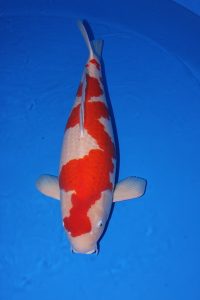
All-Japan Kohaku with an Imazuma (Lightning) pattern
Next time you are visiting a trade show or a koi dealer, take the time to study the kohakus. Bowl five or six of them up – study patterns. Study body shapes. Study color and skin quality. Maybe you’ll spot a “special” kohaku that will take you a little further down the road that is Nishikigoi.
© Bryan Bateman 2009
Sanke – The Elegant Koi by Bryan Bateman
We have previously discussed Kohaku and Showa. We now introduce Sanke, the third of the group of koi known as “Gosanke”. These three varieties traditionally win most major awards at koi shows.
In most cases a Sanke can be easily recognized by the characteristic kohaku pattern (red patterning on a white fish) accented with black markings scattered about the body much like stepping stones. As with many varieties, there are a few “rules” which should be followed. One of these is that the head should be free of any black markings. Another is that the pectoral fins should have “tejima”, or thin black stripes, extending from the pectoral joint to about one-half the length of the fin. Other than these two rules, it becomes much a matter of personal taste as to the location, size, and number of black markings.
In judging Sanke, a judge will consider the overall balance of the red and white markings – how well they compliment each other. If the black markings are concentrated in one area, such as near the tail, or all on one side, it creates an un-balanced and busy look. There should be a “focal point” on a Sanke, which would be a fairly large black marking on one shoulder. This is important enough to have its own name: “Kata Sumi”. Another appreciation point is that the black markings should be located on the white rather than on the red. This creates a more elegant and refined impression.
In selecting young Sanke, in addition to the standard checklist of good health, solid body structure, and good skin quality, you should look for a pleasing kohaku pattern. A two- or three- step pattern tends to look very nice on a Sanke because there will be several white areas upon which the black stepping stones will hopefully appear. As with most varieties exhibiting black coloration, we cannot predict for sure where these markings will be. This is one challenge of selecting a baby Sanke. Most will have black markings as Tosai (one-year-olds), but these will frequently fade away to be replaced by permanent markings by the third year or fourth year. In general, the permanent black markings will be at approximately the same locations as the “baby black”, but you can also look closely for faint gray markings, which will emerge later as normal black.
© Bryan Bateman 2009
Goromo – An Amazing Breed by Bryan Bateman
Of all the beautiful varieties of koi that have been developed over the years, to me the Ai Goromo takes the prize as the most amazing accomplishment by the breeders of Japan. Ai Goromo is easily recognized by the delicate blue edging, or reticulation, on each red scale on a pattern of what would otherwise be a kohaku. Its cousin, the Goshiki, is an interesting contrast with its typical blue edging on the white. These two varieties are frequently combined as a single variety for koi show purposes.
Two sub-types of Goromo, Sumi Goromo and Budo Goromo, are not as elegant or refined in appearance, and consequently don’t generally compete very well in shows against a good Ai Goromo. Sumi Goromo has a much darker and heavier edging, and the Budo Goromo has “grape clusters” (translation of “Budo”) mixed in with the normal reticulation. These two sub-types can sometimes be mistaken as shiro utsuri (black and white koi) due to the dark ai (blue) almost completely covering the red, but if you look closely you will see the red appear as a dark purple thru the almost black pattern.
Ai Goromo was probably developed by crossing an Asagi with a Kohaku. As a result of this cross, the Ai Goromo inherited a striking bluish-white background from its Asagi parent.
When selecting a young Ai Goromo, look for one with an attractive kohaku pattern and with reticulation that is barely visible if at all. This is why this variety is such a challenge to collect. You must be sure of the parentage, and even then there can be no guarantee that the reticulation will come, or that it will be even. The reticulation tends to darken and thicken with age, so if you buy a young (one or two years old) Goromo that appears to be a nearly finished Ai Goromo, the chance is very good that it will darken and become either a Budo or a Sumi Goromo. If, on the other hand, you are lucky enough to find one that develops into this most rare beauty, with each red scale outlined in a thin crescent-moon of blue, it will take your breath away. Happy hunting!
© Bryan Bateman 2009
Goshiki – “five-colored” by Bryan Bateman
I have always been fascinated with the Goshiki variety, with its many variations of color, reticulation and pattern. Recently goshiki have been divided into two sub-types: Light, or mameshibori (also sometimes called kindai) goshiki, and dark, or kuro goshiki.
The light version looks much like a kohaku but with thin crescent-shaped dark blue reticulation appearing on the white skin, whereas the darker kuro goshiki sometimes has reticulation on the red as well, with the white area becoming almost completely dominated by heavy dark blue reticulation – appearing almost like black or dark purple rather than white.
The original meaning of goshiki is “five-colored”. These colors are white, black, red, light blue, and dark blue. When mixed on some goshiki (i.e. kuro) the ground (main, or background color of the body) can appear as purple, which makes for a really cool looking fish!
This variety was originally placed in the kawarimono (or “miscellaneous”) class for judging purposes, but due to great efforts to improve and refine the variety, it was recently upgraded to a combined koromo/goshiki class.
The reason these two varieties are combined into one class is that they are of the same genetic blend – kohaku and Asagi. The kohaku gene contributes the red patterning on a white background while the Asagi gene contributes the reticulation. In the case of koromo this reticulation is restricted to the red areas, while with goshiki the reticulation is usually restricted to the white areas (the exception being kuro goshiki as mentioned above which sometimes has reticulation on both the red and white areas).
Two popular variations of goshiki are goshiki sanke ( aka goshiki sanshoku) and goshiki showa. These will appear as normal goshiki with added small black patches in the case of goshiki sanke or with added larger black wrapping markings in the case of goshiki showa. Both of these types are placed in the kawarimono class for judging purposes.
When selecting a young goshiki for your collection you should first look for a pleasing kohaku pattern. Sandan (three-step) is ideal on a goshiki because it provides for a large amount of white area to accentuate the reticulation. Judges are a bit more lenient regarding the placement of the red on the head of a goshiki. For example, a goshiki with either too much or not enough red between the tip of the nose and the eyes will be acceptable as long as the red is bright and clean and the white provides a pleasing background, giving the koi an artistic look.
The fins should be either all white or can have red at the base (moto aka). The reticulation should be even (not irregular or splotchy appearing) and the red should appear almost to be floating on the ground – a unique characteristic of high quality goshiki. Young goshiki will often appear to be kohaku, as the reticulation normally does not appear until later. You have to trust your dealer in this respect, who should know the lineage of the fish he is selling.
Whether you fancy the kuro goshiki or the elusive ( ‘been looking for one for years!) mameshibori goshiki, this variety will certainly delight and will be a big attraction in your pond.
© Bryan Bateman 2009

